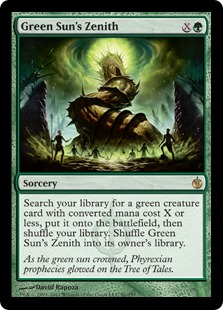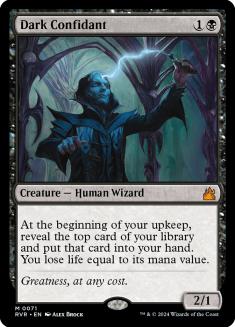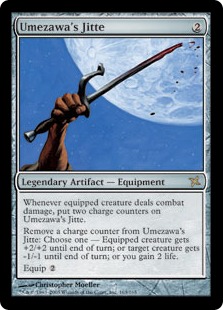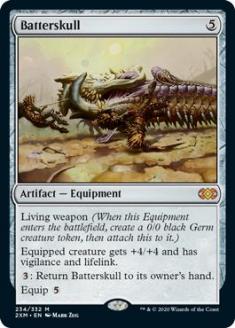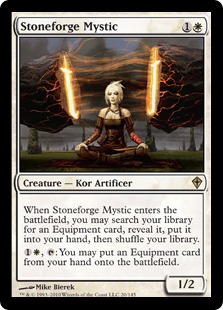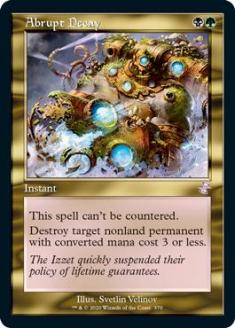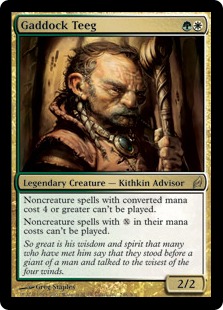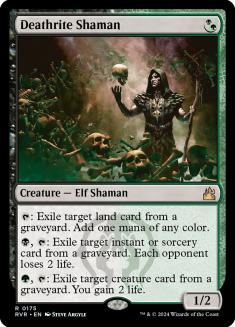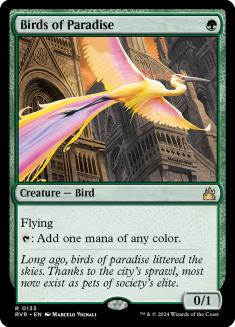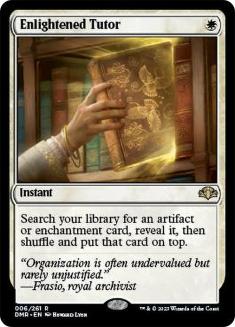About a year ago, Maverick was considered a top tier Legacy deck. It, along with Stoneblade and RUG Delver, put up consistent showings on the SCG circuit despite eschewing both Brainstorm and Force of Will. Now, it’s rare to see a Maverick list do well.
What happened?
Griselbrand’s printing meant that Show and Tell and Reanimator could now beat Karakas, which is Maverick’s main defense from scary creatures. With Return to Ravnica, many high profile players theorized that Deathrite Shaman would be the death of Knight of the Reliquary strategies. With Grand Prix Denver, Jund began to rise in popularity and became the most popular non-blue “fair” deck.


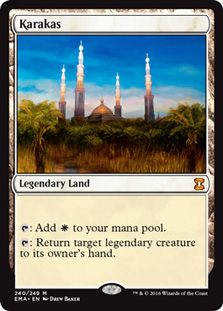
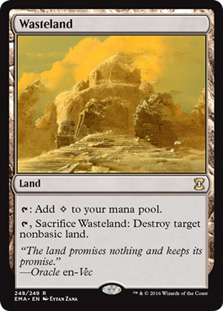
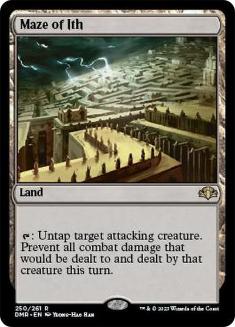
The story behind my version of Maverick starts in February of this year. After about seven months of not playing in large Magic tournaments, I decided to get back into Legacy by attending a local Legacy tournament. I dusted off my G/W Maverick deck, took it apart, and built it from the ground up the day before the tournament.
I started with the core of the deck: four Green Sun’s Zenith, four Knight of the Reliquary, and four Mother of Runes. I filled in my favorite situational green creatures and utility lands. I knew I was splashing black for the new best mana dork, Deathrite Shaman. Dark Confidant seemed like a natural addition alongside Deathrite Shaman and Mother of Runes. To deal with the RUG Delver and Counterbalance lists that had popped up recently, I added two Abrupt Decay in addition to the standard four Swords to Plowshares. Finally, I put in four Duress help slow down my combo opponents. Here’s what I ended up playing:
Creatures (20)
- 4 Mother of Runes
- 4 Dark Confidant
- 1 Scryb Ranger
- 4 Knight of the Reliquary
- 2 Qasali Pridemage
- 1 Scavenging Ooze
- 4 Deathrite Shaman
Lands (23)
Spells (17)

In seven rounds, I did not lose a single game. I got a few good matchups and a few good breaks here and there, but I was convinced: Knight of the Reliquary is still a real Magic card. Sure, it didn’t get as big as it used to, but it trumps pretty much any threat an opponent throws at you. Facing down a giant spaghetti monster Get Karakas and bounce it. Facing down powerful equipment? Get Maze of Ith to prevent damage. Utility lands? Wasteland. Flooded? Cycle Horizon Canopy. Of course, once you are done surviving, it attacks back for a ton of damage, often ending the game in one or two swings.
Some notable changes between that list and the one I utilized this past weekend explained:
- -4 Dark Confidant
- -1 Umezawa’s Jitte
- +1 Batterskull
- +2 Stoneforge Mystic
I knew I wanted a utility two-drop, but my experience with Maverick told me that Stoneforge Mystic and Tarmogoyf were both awful in this deck. Dark Confidant seemed like a logical inclusion enabled by the black splash because of its ability to generate advantage as the game goes on, but I found that having to fetch a black-producing land and the life loss were both liabilities.
Games I have lost since February often involved some combination of Tarmogoyf and Wasteland, so I felt like the one-time tutor for a life-gaining threat was much more valuable than the extra cards provided by Dark Confidant. I cut an Umezawa’s Jitte for Batterskull because it is less mana-intensive (ironically) to utilize. If I was stuck on mana or wanted to Wasteland my opponent, Batterskull functioned nicely as a reasonable two mana lifelinker.
- -4 Duress
- +4 Thoughtseize
Notice the lack of Thalia, Guardian of Thraben in my list. She’s good against Storm and Belcher but pretty awful almost anywhere else. The deck runs a nontrivial number of noncreature spells, so Thalia, Guardian of Thraben’s taxing ability is truly double-sided. Instead of delaying their noncreature spells, why not just make them discard them? I ran into a few situations where I wanted my Sneak and Show opponent to discard Emrakul or Griselbrand, so with the switch away from Dark Confidant I felt comfortable playing a full set of Thoughtseizes.
- -2 Abrupt Decay
- +1 Gaddock Teeg
- +1 Maze of Ith
- +1 Scavenging Ooze
Simply put, I had too much removal in my maindeck. Knight of the Reliquary effectively blanks most ground creatures, and I wanted the extra tutor targets to be as versatile as possible in game 1. The Gaddock Teeg maindeck was insane for me over the weekend, and I would definitely keep him there.
I think this change has attracted the most questions from people. I found that having four Deathrite Shaman and four Green Sun’s Zenith forced me to eat lands out of my own graveyard more often than I’d like or worse not have any lands for fuel at all. I started with a 3/1 split with the Birds of Paradise as a Green Sun’s Zenith target, but I eventually decided that good ol’ Birds was good enough to include a second copy. Also not irrelevant is its evasion, which allows Birds to get an Equipment hit through or chump block a problematic flier.
- -1 Wasteland
- +1 Horizon Canopy
In a deck with 23 lands, I was having a lot of trouble actually casting my spells. Removing Dark Confidant helped with that, as did adding an additional G/W land. Plus, it’s very rare that you actually Wasteland an opponent more than three times in a game even with Knight of the Reliquary out.
I don’t think the two life was ever relevant, but strict upgrades never hurt.
The sideboard underwent a few small changes, but the core of it stayed intact. The most important aspect is the Enlightened Tutor package—effectively playing four copies of some very powerful hate cards. Yes, Enlightened Tutor feels pretty bad because you’re throwing away a card, but the tutor targets are so powerful that it is worth it. Here’s the final list I played at SCG Legacy Open: Seattle:
Creatures (21)
- 4 Mother of Runes
- 2 Birds of Paradise
- 1 Scryb Ranger
- 1 Gaddock Teeg
- 4 Knight of the Reliquary
- 2 Qasali Pridemage
- 2 Stoneforge Mystic
- 2 Scavenging Ooze
- 3 Deathrite Shaman
Lands (24)
Spells (15)

Instead of giving a full-on tournament report, I’m just going to list the matchup, result, and short descriptions.
Round 1: Merfolk, 2-0. Knight of the Reliquary is pretty much impossible for them to deal with once resolved.
Round 2: U/W Miracles, 2-1. After losing game 1, I won game 2 through Moat + Humility + Ensnaring Bridge with a timely Abrupt Decay and then closed out the match on turn 5 of turns. Counterbalance / Sensei’s Divining Top is actually pretty manageable for Maverick, as Green Sun’s Zenith’s CMC is 1 + X while on the stack.
Round 3: Elves, 0-2. A combination of playing a little too aggressively and drawing my Enlightened Tutor one turn too late meant that I got run over by a Craterhoof Behemoth twice.
Round 4: Omni-Tell, 2-0. Gaddock Teeg didn’t stop my opponent from coming to class with Omniscience, but it prevented him from Entering the Infinite. In game 2, he brought aliens to class, but I was prepared with my Knight of the Reliquary.
Round 5: Reanimator, 2-0. Somehow, my Swords to Plowshares resolved against his turn 2 Griselbrand game 1. In game 2, I managed to get a fast Scavenging Ooze online after stupidly playing my Tormod’s Crypt into a Spell Pierce.
Round 6: U/W/R Landstill, 2-0. I think I was on camera for part of this match. My opponent was playing a cross of a Modern deck and Landstill, which may have been great against combo decks but certainly not against Knight of the Reliquary.
Round 7: Tim Edgar with RUG, 2-1. Tim offered to scoop to me so that I could carry the torch for our little playtesting team. Despite this, we got a feature match and played a very casual three games of Magic. Unfortunately, he scooped right when I got to the five mana I needed to hard cast my Batterskull. 🙁
Round 8: TES, 2-0. Natural Gaddock Teeg got game 1, and a pair of Deathrite Shamans with the aid of some 1/1s held off an Empty the Warrens for twelve Goblins in game 2. Why on earth does Deathrite Shaman have two toughness?
Round 9: Tim Froehlig with RUG, 2-1. After winning game 1, I missed a crucial Scryb Ranger untap in game 2. In game 3, he probed me and saw no Wasteland, causing him to cast Lightning Bolt instead of a cantrip on turn 1. A Wasteland off the top mana screwed him out of the game. I don’t feel good about wins like that, but hey, it’s part of the game.
After nine rounds of Swiss, I was the first seed at 8-1, which meant that I had to play against:
Quarterfinals: Joe Lossett with U/W/R Miracles, 2-1
I’ll be the first to admit that I may not have deserved to win this match.
I’m a huge fan of Joe’s, and I’ve spent several hours glued to SCGLive watching him work his way out of seemingly impossible situations. In game 1, he almost beat Mother of Runes + Gaddock Teeg by using Karakas to bounce Teeg then using Vendilion Clique to send him to the bottom of my library, but he lost to a large Knight of the Reliquary shortly after. Game 2 started with me mulliganing twice, and to make matters worse I played right into his tricks and traps roughly 50 times shortly thereafter.
Game 3 was on camera and contained one of the biggest mistakes I’ve ever made as a Magic player. On turn 2, I resolved a Stoneforge Mystic only to realize that I had boarded out all three pieces of equipment for the final game despite Batterskull very good in this matchup. Joe did the smart thing and assumed that I had Batterskull in hand already, but giving me too much credit may have been his downfall.
He wasted a pair of sweepers on my Squires in anticipation of Batterskull hitting the table though in reality he was in no danger. I will say this: I’m proud of the way I played despite making such a horrendous blunder. Rather than tilting and giving away the final game, I stuck it out and eventually found a way to win. A Thoughtseize cleared the way for a Green Sun’s Zenith for Gaddock Teeg, and that’s all that ended up mattering.
I have to comment on Joe’s mental fortitude here. While my play was deteriorating toward the end of our 80-minute match, Joe was as sharp as when the match had started, and he seemingly never missed a play for each of the hundred thousand tiny decisions he made. I have no idea how he manages to play Miracles as well as he does for 10+ hours on the day of the tournament, and I’m sure it won’t be long before he gets his ninth Legacy Top 8.
Semifinals: Chris Morris-Lent with Merfolk, 2-0
You can find the written coverage here.
Despite not being able to think clearly after my match with Joe, I was at least able to resolve a few Knight of the Reliquarys and take the match easily from there.
Finals: Bryan Eleyet with Hive Mind, 0-2
Apparently this is a pretty bad matchup, and I’m really glad that I didn’t have to play against it any other time during the day. The only thing I can really hope for is a draw that disrupts the opponent just long enough to get to the point where I can pay for a Pact, which didn’t happen in either game. Congratulations again to Bryan for taking down the tournament; it’s been a while since we’ve seen a Hive Mind list do so well.
I’ve been trying to convince people for a while that Maverick is still a legitimate strategy, and I’m definitely glad that I have the results to back it up. Overall, I had a great time playing the deck and format I love at SCG Legacy Open: Seattle, and I recommend to anybody who misses casting Knight of the Reliquary or Green Sun’s Zenith to dust off their old Maverick cards for an upcoming Legacy tournament. Special thanks to Brent for letting me use his Thoughtseizes and Jon for hosting me for the weekend (even if his air mattress leaked to the point where I woke up on the floor each morning!). For everybody else, keep playing Legacy and introducing your friends to this wonderful, underappreciated format we love.
Until next time,
 |
We are Selesnya. We all about the fair fight. Thalia and Ethersworn Canonist ensure that our adversaries play fair as well. It’s a harsh multiverse out there full of agonizing tendrils, flying spaghetti monsters, and oversized insects. But if we can stand together and unite our powers, we can survive any battle, bolts of lightning, and even the sudden urge to plow fields. We do not discriminate who joins our ranks. Humans, Elves, Kor, Dryads, Faeries–even Oozes, Giants, and the occasional Praetor–we all believe in the Worldsoul and stand to protect it. We are Selesnya, and we will prevail. |

